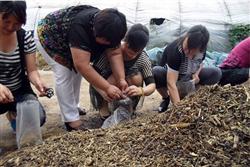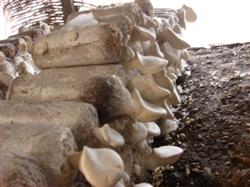Cultivation techniques of Pleurotus ostreatus: how to breed Pleurotus ostreatus?

How to raise Pleurotus ostreatus? Please give a detailed introduction to the short-term cultivation of Pleurotus ostreatus can refer to the following methods: first, Pleurotus ostreatus is a medium-low temperature variety, which is extremely sensitive to temperature, and its hyphae adapt to a wide range of temperature and can survive at the temperature of 4 ℃ ~ 37 ℃, but the suitable temperature for its growth period is 23 ℃ ~ 28 ℃, the temperature for post-ripening of hyphae is 5 ℃ ~ 30 ℃, and the temperature range for mushroom emergence is 0 ℃ ~ 25 ℃, but the temperature at the bud stage in the early stage of growth is 8 ℃ ~ 13 ℃. In the later stage, the suitable growth temperature of young mushroom is 15 ℃. It is not difficult to see that the temperature for the growth of Pleurotus ostreatus fruiting body is low at first and then high. Second, another characteristic of Pleurotus ostreatus is that it takes quite a long post-ripening stage for mycelium growth to reach physiological maturity, that is, after the mycelium is full, Pleurotus ostreatus bags can not produce mushrooms directly like Pleurotus ostreatus, but must go through a post-ripening stage of mycelium to produce mushrooms. According to the different characteristics of strains, this stage generally takes about 60 days, and some strains even as high as 80 days, which is extremely inconvenient in production arrangement, which greatly prolongs the production cycle and relatively reduces the efficiency of production and management. The core of artificial regulation and control of short-breeding, high-quality and high-yield technology of Pleurotus ostreatus is to shorten the post-ripening period of Pleurotus ostreatus and produce mushrooms smoothly by artificially regulating the temperature condition of the post-ripening stage of Pleurotus ostreatus hyphae. The basic methods are as follows: first, the temperature of the post-ripening stage of mycelium is adjusted to 30 ℃ for about 10 days, so that the hyphae fully develop, and then the temperature is lowered to maintain for about 15 days at the temperature of 0 ℃ ~ 10 ℃, so that the hyphae form self-protection under relatively uncomfortable conditions, so as to accelerate the process of its development. General strains can be successfully transferred to reproductive growth after a temperature control cycle, while individual strains need two temperature control cycles to transfer to reproductive growth. Third, when the bacterial bag has a whiter color, makes a sound like tapping hollow wood, and has high hardness and strong elasticity, it can be removed from the cold storage and into the plastic greenhouse. At this time, we should try to increase the temperature of the shed, increase the humidity, give an appropriate amount of strong light stimulation and greater ventilation. After moving into the plastic greenhouse for about 7 days, the yellowish bacterial liquid appeared at the inoculation block. After that, the temperature should be lowered as much as possible, waiting for it to bud. In general, the greenhouse temperature should be kept below 15 ℃, cover the grass grass, strengthen the ventilation in the morning and evening, and strengthen the ground watering and space spraying at the same time. Mushroom buds can be formed quickly in a few days at a low temperature below 15 ℃. 4. Generally speaking, each mushroom noodle can produce 1-3 mushroom buds, and only one mushroom bud can be kept before the differentiation is completed. Click to get more Pleurotus ostreatus planting technology click to get more edible mushroom planting technology
- Prev

Cultivation techniques of Pleurotus ostreatus: how to match the cultivation raw materials of Pleurotus ostreatus?
How to match the cultivation raw materials of Pleurotus ostreatus? Please give guidance to Pleurotus ostreatus cultivation raw materials can refer to the following methods: the added nutrients should be based on organic nutrition, supplemented by inorganic nutrition, which is very helpful to enhance the stamina of Pleurotus ostreatus. Organic nutrients are generally wheat bran, corn flour, rice.
- Next

Cultivation techniques of Pleurotus ostreatus: how to configure and disinfect the cultivation materials of Pleurotus ostreatus?
How to configure and disinfect the cultivation material of Pleurotus ostreatus? Please introduce the configuration and disinfection of Pleurotus ostreatus cultivation materials, please refer to the following methods: 1. The preparation of cultivation materials: 100 kg of cottonseed hull, 5 kg of corn meal, 5 kg of wheat bran, 3 kg of lime and 2 kg of gypsum. two。 Composting fermentation: the best material for composting fermentation is 300 grams.
Related
- Fuxing push coffee new agricultural production and marketing class: lack of small-scale processing plants
- Jujube rice field leisure farm deep ploughing Yilan for five years to create a space for organic food and play
- Nongyu Farm-A trial of organic papaya for brave women with advanced technology
- Four points for attention in the prevention and control of diseases and insect pests of edible fungi
- How to add nutrient solution to Edible Fungi
- Is there any good way to control edible fungus mites?
- Open Inoculation Technology of Edible Fungi
- Is there any clever way to use fertilizer for edible fungus in winter?
- What agents are used to kill the pathogens of edible fungi in the mushroom shed?
- Rapid drying of Edible Fungi

